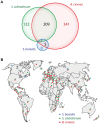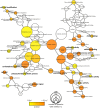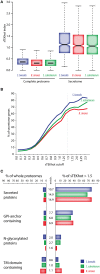Common protein sequence signatures associate with Sclerotinia borealis lifestyle and secretion in fungal pathogens of the Sclerotiniaceae
- PMID: 26442085
- PMCID: PMC4585107
- DOI: 10.3389/fpls.2015.00776
Common protein sequence signatures associate with Sclerotinia borealis lifestyle and secretion in fungal pathogens of the Sclerotiniaceae
Abstract
Fungal plant pathogens produce secreted proteins adapted to function outside fungal cells to facilitate colonization of their hosts. In many cases such as for fungi from the Sclerotiniaceae family the repertoire and function of secreted proteins remains elusive. In the Sclerotiniaceae, whereas Sclerotinia sclerotiorum and Botrytis cinerea are cosmopolitan broad host-range plant pathogens, Sclerotinia borealis has a psychrophilic lifestyle with a low optimal growth temperature, a narrow host range and geographic distribution. To spread successfully, S. borealis must synthesize proteins adapted to function in its specific environment. The search for signatures of adaptation to S. borealis lifestyle may therefore help revealing proteins critical for colonization of the environment by Sclerotiniaceae fungi. Here, we analyzed amino acids usage and intrinsic protein disorder in alignments of groups of orthologous proteins from the three Sclerotiniaceae species. We found that enrichment in Thr, depletion in Glu and Lys, and low disorder frequency in hot loops are significantly associated with S. borealis proteins. We designed an index to report bias in these properties and found that high index proteins were enriched among secreted proteins in the three Sclerotiniaceae fungi. High index proteins were also enriched in function associated with plant colonization in S. borealis, and in in planta-induced genes in S. sclerotiorum. We highlight a novel putative antifreeze protein and a novel putative lytic polysaccharide monooxygenase identified through our pipeline as candidate proteins involved in colonization of the environment. Our findings suggest that similar protein signatures associate with S. borealis lifestyle and with secretion in the Sclerotiniaceae. These signatures may be useful for identifying proteins of interest as targets for the management of plant diseases.
Keywords: Sclerotinia; amino acid usage; antifreeze protein; effector candidates; intrinsic disorder; lytic polysaccharide monooxygenase; psychrophily; secretome.
Figures








Similar articles
-
An Interspecies Comparative Analysis of the Predicted Secretomes of the Necrotrophic Plant Pathogens Sclerotinia sclerotiorum and Botrytis cinerea.PLoS One. 2015 Jun 24;10(6):e0130534. doi: 10.1371/journal.pone.0130534. eCollection 2015. PLoS One. 2015. PMID: 26107498 Free PMC article.
-
Identification of the Viral Determinant of Hypovirulence and Host Range in Sclerotiniaceae of a Genomovirus Reconstructed from the Plant Metagenome.J Virol. 2021 Aug 10;95(17):e0026421. doi: 10.1128/JVI.00264-21. Epub 2021 Aug 10. J Virol. 2021. PMID: 34132570 Free PMC article.
-
Conservation and expansion of a necrosis-inducing small secreted protein family from host-variable phytopathogens of the Sclerotiniaceae.Mol Plant Pathol. 2020 Apr;21(4):512-526. doi: 10.1111/mpp.12913. Epub 2020 Feb 15. Mol Plant Pathol. 2020. PMID: 32061186 Free PMC article.
-
Emerging Trends in Molecular Interactions between Plants and the Broad Host Range Fungal Pathogens Botrytis cinerea and Sclerotinia sclerotiorum.Front Plant Sci. 2016 Mar 31;7:422. doi: 10.3389/fpls.2016.00422. eCollection 2016. Front Plant Sci. 2016. PMID: 27066056 Free PMC article. Review.
-
Unraveling the in vitro secretome of the phytopathogen Botrytis cinerea to understand the interaction with its hosts.Front Plant Sci. 2015 Oct 9;6:839. doi: 10.3389/fpls.2015.00839. eCollection 2015. Front Plant Sci. 2015. PMID: 26500673 Free PMC article. Review.
Cited by
-
Native and Alien Antarctic Grasses as a Habitat for Fungi.Int J Mol Sci. 2024 Aug 3;25(15):8475. doi: 10.3390/ijms25158475. Int J Mol Sci. 2024. PMID: 39126044 Free PMC article.
-
Shifts in diversification rates and host jump frequencies shaped the diversity of host range among Sclerotiniaceae fungal plant pathogens.Mol Ecol. 2018 Mar;27(5):1309-1323. doi: 10.1111/mec.14523. Epub 2018 Mar 23. Mol Ecol. 2018. PMID: 29421852 Free PMC article.
-
Rapid identification of an Arabidopsis NLR gene as a candidate conferring susceptibility to Sclerotinia sclerotiorum using time-resolved automated phenotyping.Plant J. 2020 Jul;103(2):903-917. doi: 10.1111/tpj.14747. Epub 2020 Apr 21. Plant J. 2020. PMID: 32170798 Free PMC article.
-
Parallel evolution of the POQR prolyl oligo peptidase gene conferring plant quantitative disease resistance.PLoS Genet. 2017 Dec 22;13(12):e1007143. doi: 10.1371/journal.pgen.1007143. eCollection 2017 Dec. PLoS Genet. 2017. PMID: 29272270 Free PMC article.
-
Transcription Factor SsSte12 Was Involved in Mycelium Growth and Development in Sclerotinia sclerotiorum.Front Microbiol. 2018 Oct 17;9:2476. doi: 10.3389/fmicb.2018.02476. eCollection 2018. Front Microbiol. 2018. PMID: 30386319 Free PMC article.
References
Grants and funding
LinkOut - more resources
Full Text Sources
Other Literature Sources

